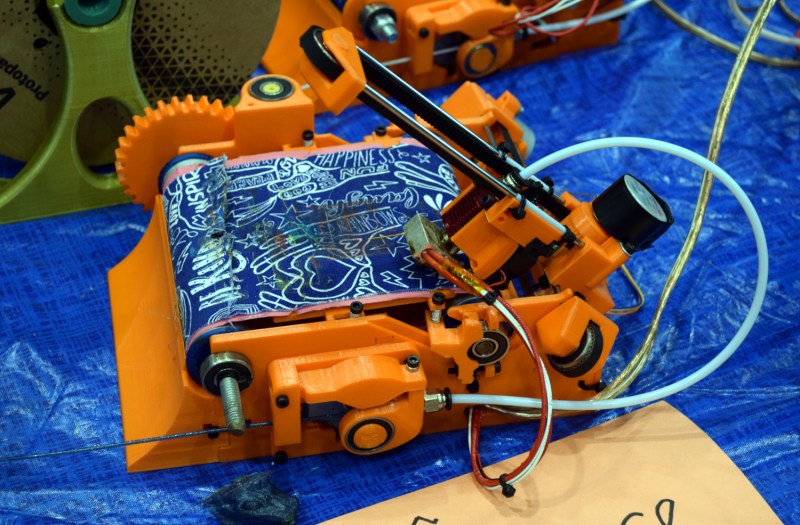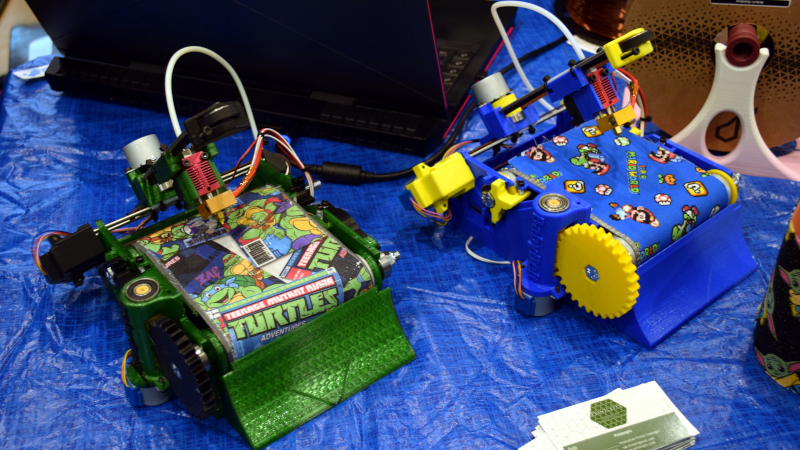Hackaday has been reporting on belt printers for around a decade now, since MakerBot released (and then quickly pulled) an automated build platform for their very first Cupcake printer. Turns out that not only has the concept been difficult to pull off from a technical perspective, but a murky patent situation made it tricky for anyone who wanted to bring their own versions to market. For a long time they seemed like the fusion reactors of desktop 3D printing — a technology that remains perennially just outside of our grasp.
But finally, things have changed. The software has matured, and there are now several commercial belt printers on the market. The trick now, as it once was for traditional desktop 3D printing, is to bring the costs down. Enter the Baby Belt, created by [Rob Mink]. This open-source belt printer relies on light-duty components and a largely 3D printed structure to get the price point down, though some will find its diminutive dimensions a bit too limiting…even if one of its axes is technically infinite.
If you’ve already got a printer and filament to burn, [Rob] is selling the part kit for just $130 USD. But even if you opt for the full ready-to-build kit, it will only set you back $180. Considering even the cheapest belt printers on the market now have a sticker price of more than $500, that’s an impressive accomplishment.
 Of course, it’s hard to compare the Baby Belt with anything else on the market. For one thing, save for a few metal rods, its frame is made almost entirely from 3D-printed parts. Rather than the NEMA 17 stepper motors that are standard on even the cheapest of traditional desktop 3D printers, this little fellow is running on the dinky 28BYJ-48 steppers that you’d expect to find in a cheap toy. Then again, considering the printer only offers 85 x 86 mm in the X and Y axis, the structure and motors don’t exactly need to be top of the line.
Of course, it’s hard to compare the Baby Belt with anything else on the market. For one thing, save for a few metal rods, its frame is made almost entirely from 3D-printed parts. Rather than the NEMA 17 stepper motors that are standard on even the cheapest of traditional desktop 3D printers, this little fellow is running on the dinky 28BYJ-48 steppers that you’d expect to find in a cheap toy. Then again, considering the printer only offers 85 x 86 mm in the X and Y axis, the structure and motors don’t exactly need to be top of the line.
What really sets this machine apart is the belt — while we’ve seen other makers go all out with their belt material, [Rob] has come up with an impressively low-tech solution. It’s a simple stack-up of construction paper, carpet tape, and fabric that you could probably put together with what you’ve got laying around the house right now.
Between that outer cloth layer and the printed frame, the Baby Belt offers a lot of room for customization, something which was on clear display at the 2022 East Coast RepRap Festival. The machines dotted several tables on the show floor, and you could tell their builders had a lot of fun making each one their own
















Lovely!!!
I am waiting for some one to built this in to a hat and print chains for hair at an event.
If you had me guess what comments I would find on this article, I never would have guessed this one even after a million tries.
I considered building one of these, but upon closer inspection it’s pretty under-spec’ed. Doesn’t even have a part cooling fan (just hot end). I haven’t built it yet, but I’m going to build an EZ-Belt instead which converts an old Ender 3 into a belt printer
At the tiny scale and relatively slow print speeds such a design maxes out at a part cooling fan is almost certainly just a waste of mass on the print head that would make printing even slower so I’d not mark it down for that. Such a tiny little printer really isn’t for anything challenging to print material wise and has such a small ‘x-y’ build volume the super long bridges that a part cooling fan really can be needed for just are not going to happen anyway.
I’d be very tempted by such a printer if I had a project in mind it really suits or the space for another one – as it does fills that niche no printer I could fit in my space otherwise does for those very long beam like objects.
Hmmm. Think SLA Infinite Z Belt Printer. Would need a roll of support material in the well of goop coming out at an angle. Then feed the web into a curing and cleaning station. Or feed the support material into the well then around and out again.
Infinite Z is a misnomer. There is a limit to the height. Its the Length that grows as you rotate the web. Should be called an Infinite Y Printer.
Also like that the “Layers” are at an angle to the height. Makes the strength of the printed part stronger at an angle to the parts “Z” axis.
The one rule of coordinate systems: somebody always prefers a different one. If you think of the gantry as a basic XY setup, then the only remaining axis is Z, though I wonder if they actually call it that in the code because it’s not orthogonal to the other axes.
Don’t know why, but on these belt printers they consider the belt to be Z. I’ve always assumed it had something to do with how the slicing software need to be modified, but just a guess.
That would be sort of my take too, though I don’t think it its much about modifying the code – its just the sensible thing to name it as conventional slicing the x-y axis prints the layer then the z steps once and the belt does that z step role of the print (at least with most belt printers I’ve seen).
It’s because the first ones to really be effective used a CoreXY top from set at an angle. X and Y for the print head motion are still mapped the same, but instead of a Z that retracts perpendicular to the XY frame, instead it heads off at a 45 degree angle. It’s still nominially “Z” mainly because X and Y are spoken for.
Also, as with most 3d printers, the ‘layer lines’ go in the XY plane, and that’s still the case on these, so by that logic Z still applies to the motion of the belt.
Very interesting! Most that I’ve seen have the belt as a closely guarded secret, even otherwise ostensibly “open” printers. Nice to see somebody share that detail.
I can only hope/assume the patent situation is better now and that’s why they’re coming to the forefront again? I know patents are necessarily for some even non-troll business models, and I’ve heard the reasoning why even publicly funded research can be patented (because otherwise nobody would use the results, which seems like a broken system but I kind of get it) but in so many areas patents seem to slow the process of technological development… Maybe I’m biased as a software developer.
Caution, the stuff in the repo is licensed cc-by-nc-sa 4.0. Attribution and share alike make sense, and I can see the appeal of non-commercial, but it always seems to have unintended consequences (eg think I couldn’t do anything with things under that license in grad school, might mean I can’t build it if I plan on printing work stuff on it ever…), and makes the license not open source per the OSI. I’m always disappointed to see the NC, not because I plan on selling bits (does it really stop folks from selling copies on AliExpress?) but because it means it’s encumbered in complicated ways I can’t remember.
IANAL, but I doubt a NC license for a printer’s design would put any limitations on commercial _use_ of the printer.
The biggest issue I see with NC, is that if you make an improvement on the design, and then, as the licence requires, release it under the same license, literally nobody can sell it, not even the original designer. It’s basically a dead end licence.
Again, IANAL, but i believe the improver could explicitly grant the original designer rights that would include commercial use. RobMink should ask a lawyer to write up something to that effect that he can _ask_ improvers to sign (but they’re not under any obligation to do so).
Hey! I am the creater of this project. I would love to hear your thoughts.
Hey Rob,
Do you plan to release the print files only, as a choice in addition to the hardware kit & complete kit?
Check out github under robmink. It’s been open source and free to download step, cpp and stls for about a year now
It’s a matter of getting an idea from lab to practical product. Any “non-broken” system would have the inventors carry it all the way through the steps and then give it all away on the public’s dime. Yeah software works because we hide the complainers in the back room ( https://stackoverflow.blog/2021/01/07/open-source-has-a-funding-problem/ ).
Hurrah! Something that uses dirt cheap 28BYJ-48 stepper motors.